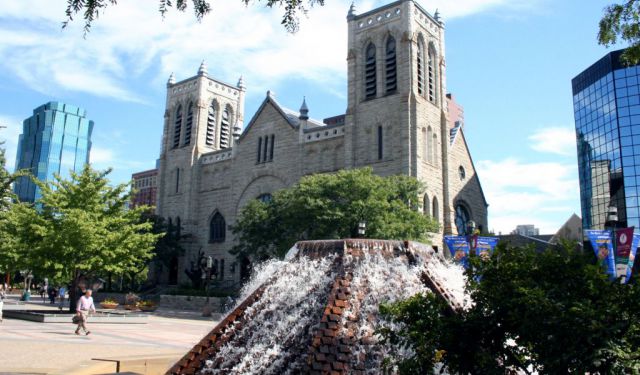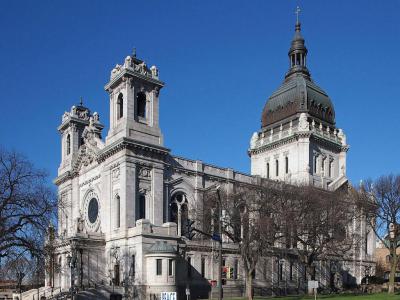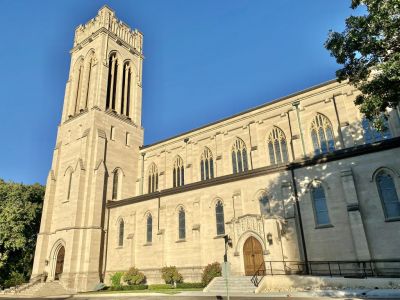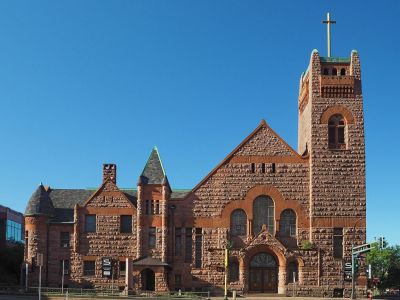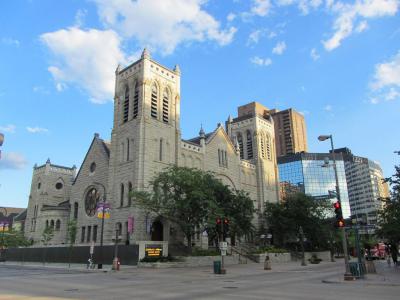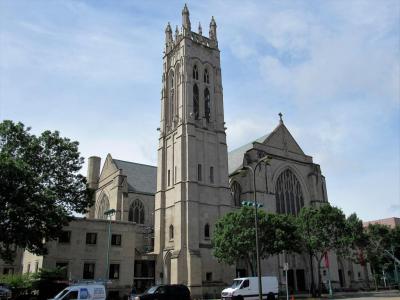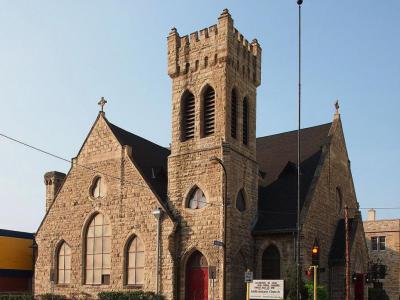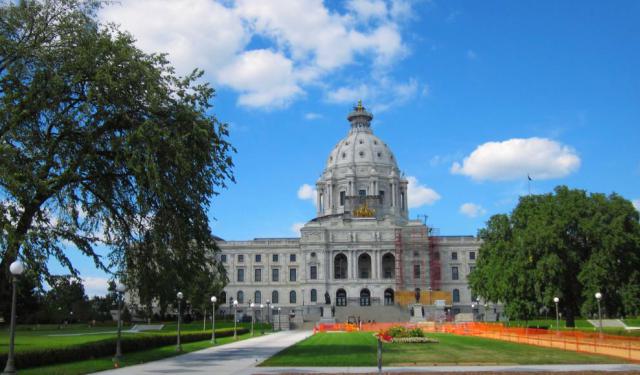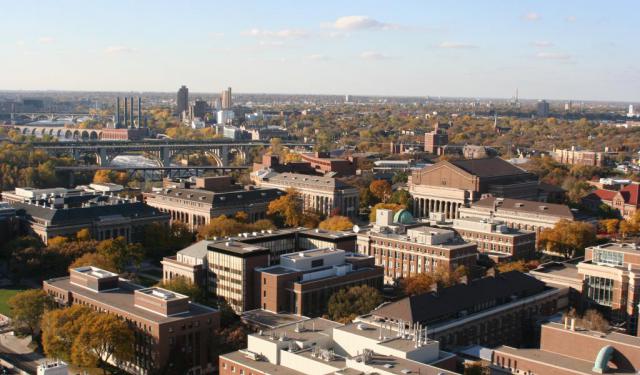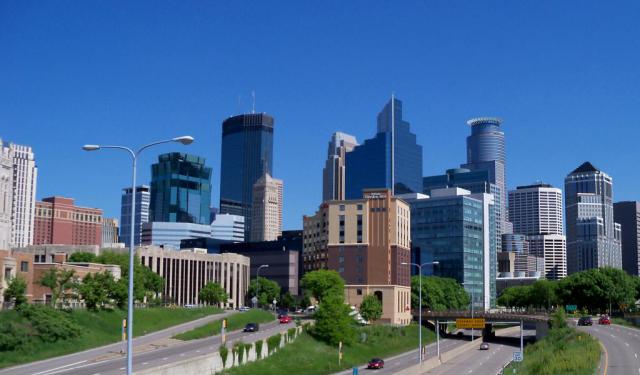Historical Churches (Self Guided), Minneapolis
The "City of Lakes”, Minneapolis, doesn't pride itself solely on the lakes. In fact, you will be amazed by how many churches, cathedrals, and other places of worship are found throughout the city. These sacred structures have played a significant role in the development of Minneapolis and continue to serve as pillars of faith and community. Let's take a look at some of the most remarkable of them.
The architectural marvel of the Basilica of Saint Mary stands as a symbol of Catholic faith in the city. Its stunning Classical Revival design and intricate stained glass windows make it a must-visit location for those seeking spiritual solace.
Saint Mark's Episcopal Cathedral, an elegant Gothic Revival cathedral, is another notable landmark. Its towering belfry and intricate stonework create a sense of awe and reverence. The cathedral's history is intertwined with the growth of the Episcopal Church in Minneapolis.
Wesley United Methodist Church, a historic congregation, holds a special place in the city's history. It has been a center of social and religious activism, reflecting the resilience and faith of its community.
Westminster Presbyterian Church is a striking example of Romanesque-Gothic architecture. Its intricate details and impressive sanctuary have made it a beloved place for worship and community gatherings.
Central Lutheran Church, with its modernist design, stands out as a testament to the city's changing architectural landscape. It embraces a contemporary approach to faith and community engagement.
Gethsemane Episcopal Church, a charming stone church nestled in a quiet neighborhood, offers a sense of peace and serenity. It has been a source of spiritual comfort for its congregation for generations.
These historical churches not only showcase remarkable architecture but also serve as reminders of Minneapolis's diverse religious traditions and the importance of faith in the lives of its residents. So, why not take a self-guided journey and experience the sense of community they provide? Your visit may leave you inspired and spiritually enriched, offering a deeper understanding of Minneapolis's cultural tapestry.
The architectural marvel of the Basilica of Saint Mary stands as a symbol of Catholic faith in the city. Its stunning Classical Revival design and intricate stained glass windows make it a must-visit location for those seeking spiritual solace.
Saint Mark's Episcopal Cathedral, an elegant Gothic Revival cathedral, is another notable landmark. Its towering belfry and intricate stonework create a sense of awe and reverence. The cathedral's history is intertwined with the growth of the Episcopal Church in Minneapolis.
Wesley United Methodist Church, a historic congregation, holds a special place in the city's history. It has been a center of social and religious activism, reflecting the resilience and faith of its community.
Westminster Presbyterian Church is a striking example of Romanesque-Gothic architecture. Its intricate details and impressive sanctuary have made it a beloved place for worship and community gatherings.
Central Lutheran Church, with its modernist design, stands out as a testament to the city's changing architectural landscape. It embraces a contemporary approach to faith and community engagement.
Gethsemane Episcopal Church, a charming stone church nestled in a quiet neighborhood, offers a sense of peace and serenity. It has been a source of spiritual comfort for its congregation for generations.
These historical churches not only showcase remarkable architecture but also serve as reminders of Minneapolis's diverse religious traditions and the importance of faith in the lives of its residents. So, why not take a self-guided journey and experience the sense of community they provide? Your visit may leave you inspired and spiritually enriched, offering a deeper understanding of Minneapolis's cultural tapestry.
How it works: Download the app "GPSmyCity: Walks in 1K+ Cities" from Apple App Store or Google Play Store to your mobile phone or tablet. The app turns your mobile device into a personal tour guide and its built-in GPS navigation functions guide you from one tour stop to next. The app works offline, so no data plan is needed when traveling abroad.
Historical Churches Map
Guide Name: Historical Churches
Guide Location: USA » Minneapolis (See other walking tours in Minneapolis)
Guide Type: Self-guided Walking Tour (Sightseeing)
# of Attractions: 6
Tour Duration: 1 Hour(s)
Travel Distance: 2.8 Km or 1.7 Miles
Author: ChristineS
Sight(s) Featured in This Guide:
Guide Location: USA » Minneapolis (See other walking tours in Minneapolis)
Guide Type: Self-guided Walking Tour (Sightseeing)
# of Attractions: 6
Tour Duration: 1 Hour(s)
Travel Distance: 2.8 Km or 1.7 Miles
Author: ChristineS
Sight(s) Featured in This Guide:
- Basilica of St. Mary
- St. Mark's Episcopal Cathedral
- Wesley United Methodist Church
- Westminster Presbyterian Church
- Central Lutheran Church
- Gethsemane Episcopal Church
1) Basilica of St. Mary (must see)
The Basilica of Saint Mary, one of the finest Neoclassical Beaux-Arts creations in the U.S., was quite the million-dollar project. Archbishop John Ireland tapped Emmanuel Louis Masqueray, a French-trained architectural wizard fresh off designing the 1904 Saint Louis World’s Fair, to give the building its flair. Masqueray, a Renaissance and Baroque enthusiast, got to work in 1907. But between World War I stretching resources thin and Masqueray’s untimely passing in 1917, it wasn’t until 1926 that the Basilica reached its full glory. Pope Pius XI later crowned it the first Basilica in North America, and it joined the National Register of Historic Places in 1975.
This architectural wonder is admired for three main reasons: its stellar design and Baroque influence, its role in Minnesota’s religious history, and, of course, its groundbreaking status as the first U.S. basilica. Inside, visitors can marvel at the dazzling stained-glass windows (completed in 1924) and a permanent art collection filled with sculptures and paintings.
But to most Minneapolitans, the Basilica is also home to something a bit less traditional: the Basilica Block Party, the city’s beloved late-summer celebration of alt-rock and community spirit.
This architectural wonder is admired for three main reasons: its stellar design and Baroque influence, its role in Minnesota’s religious history, and, of course, its groundbreaking status as the first U.S. basilica. Inside, visitors can marvel at the dazzling stained-glass windows (completed in 1924) and a permanent art collection filled with sculptures and paintings.
But to most Minneapolitans, the Basilica is also home to something a bit less traditional: the Basilica Block Party, the city’s beloved late-summer celebration of alt-rock and community spirit.
2) St. Mark's Episcopal Cathedral
Saint Mark’s Episcopal Cathedral, one of Minnesota’s two Episcopal cathedrals, began humbly in 1858 as a tiny wooden church in North Minneapolis, originally a mission of downtown’s Gethsemane parish. The congregation quickly realized their modest 18-by-45-foot building was too snug, and so the church embarked on a series of relocations. In 1863, it famously hitched a ride on a sled pulled by thirty-three oxen to a new plot donated in the city center. As the city’s land prices climbed, the church shifted several more times before settling into its home on Hennepin Avenue in 1910, overlooking Loring Park. Architect Edwin Hawley Hewitt-a parishioner himself-designed this new structure. The cornerstone was laid in November 1908, and the Parish House went up first, temporarily doubling as the worship space until the main cathedral was ready. By the 1930s, Bishop Samuel Cook Edsall had moved to Minneapolis and was already referring to Saint Mark’s as a “Pro-Cathedral.”
Official cathedral status arrived in 1941, and Saint Mark’s wasted no time making history. In 1954, it hosted the first-ever World Congress of the Anglican Communion outside the UK. The 1976 General Convention, which gave the nod to ordaining women priests and introduced the current Book of Common Prayer, also took place here. Saint Mark’s later found itself in the spotlight again in 2003, when the General Convention confirmed the Episcopal Church’s first openly gay, noncelibate bishop.
Music, meanwhile, has remained at the heart of Saint Mark’s identity. The cathedral is home to a vibrant music program that includes the Cathedral Choir, the Cathedral Choristers, and the Small Singers, as well as the Cathedral Choral Society, which welcomes singers from both the congregation and the broader community. In 2012, the pipe organ underwent a major overhaul, ensuring the music ministry stayed in top form. The Saint Mark’s Music Series offers an eclectic range of concerts, recitals, and performances featuring the Cathedral Choir, Choral Society, Canon Musician Raymond Johnston, and a host of talented guest artists.
Official cathedral status arrived in 1941, and Saint Mark’s wasted no time making history. In 1954, it hosted the first-ever World Congress of the Anglican Communion outside the UK. The 1976 General Convention, which gave the nod to ordaining women priests and introduced the current Book of Common Prayer, also took place here. Saint Mark’s later found itself in the spotlight again in 2003, when the General Convention confirmed the Episcopal Church’s first openly gay, noncelibate bishop.
Music, meanwhile, has remained at the heart of Saint Mark’s identity. The cathedral is home to a vibrant music program that includes the Cathedral Choir, the Cathedral Choristers, and the Small Singers, as well as the Cathedral Choral Society, which welcomes singers from both the congregation and the broader community. In 2012, the pipe organ underwent a major overhaul, ensuring the music ministry stayed in top form. The Saint Mark’s Music Series offers an eclectic range of concerts, recitals, and performances featuring the Cathedral Choir, Choral Society, Canon Musician Raymond Johnston, and a host of talented guest artists.
3) Wesley United Methodist Church
A Richardsonian Romanesque classic made of granite, brick, and sandstone, topped off with round-arched windows and a healthy serving of towers, Wesley United rose during Minneapolis’ late-19th-century building boom, gracing the leafy residential streets of Loring Park at 101 Grant Street East. Warren H. Hayes, the city’s go-to church architect of the era, lent his expertise to the project. Hayes was already renowned for designs like the Calvary Baptist Church, Fowler Methodist Episcopal Church, and the First Congregational Church in Minneapolis, as well as the Central Presbyterian Church over in Saint Paul. These days, the church has been dwarfed by the hulking Minneapolis Convention Center, casting a modern shadow over its historic charm.
In 1968, the church acquired its current moniker, Wesley United Methodist Church, following the union of the Methodist Episcopal Church and the Evangelical United Brethren Church. By 2010, the Preservation Alliance of Minnesota deemed it one of the state’s 10 Most Endangered Historic Places. Despite that designation, the building is still buzzing with life. It’s now home to Substance Church, a nondenominational, Evangelical megachurch known for mixing ultra-modern worship styles with small-group “cell” ministry and a relaxed “café church” vibe-all under the megachurch umbrella. Outreach Magazine even ranked Substance as the 21st fastest-growing congregation in the United States in 2010 (and 8th for growth percentage). Thanks to its trendsetting blend of contemporary methods, Substance Church continues to bring fresh energy to this historic space.
In 1968, the church acquired its current moniker, Wesley United Methodist Church, following the union of the Methodist Episcopal Church and the Evangelical United Brethren Church. By 2010, the Preservation Alliance of Minnesota deemed it one of the state’s 10 Most Endangered Historic Places. Despite that designation, the building is still buzzing with life. It’s now home to Substance Church, a nondenominational, Evangelical megachurch known for mixing ultra-modern worship styles with small-group “cell” ministry and a relaxed “café church” vibe-all under the megachurch umbrella. Outreach Magazine even ranked Substance as the 21st fastest-growing congregation in the United States in 2010 (and 8th for growth percentage). Thanks to its trendsetting blend of contemporary methods, Substance Church continues to bring fresh energy to this historic space.
4) Westminster Presbyterian Church
Westminster Presbyterian Church has played a real-life game of musical chairs in downtown Minneapolis, shifting locations three times in its 140-plus-year history. The congregation started small in 1857, just eight folks of Scottish, Irish, and Welsh descent. By 1860, they built their first church, but growth came fast, leaving them with a holy problem: not enough pews. In 1883, a bigger church was underway. Sadly, that second building had an all-too-fiery demise, leading the congregation to rebuild once more-this time at Twelfth Street and Nicollet Mall. The current church opened its doors in 1897, with a design cooked up by two Minneapolis architecture big shots, Warren H. Hayes and Charles S. Sedgwick. A century later, in 1998, the congregation gave the sanctuary a $3.5 million glow-up, restoring original design elements, boosting lighting and sound, and generally sprucing the place up.
But Westminster isn’t just about history-it’s also pretty slick when it comes to modern eco-friendly upgrades. In 2018, the church installed a stormwater reuse system so innovative it might make a hydrologist shed a single tear of joy. Rainwater from over 13,000 square feet of rooftop is gathered into six massive tanks tucked beneath the parking garage. Instead of letting it go to waste, the church puts that water to work-flushing toilets, irrigating plants, and even feeding a fancy fountain on Nicollet Mall. The system is estimated to save 122,400 gallons of potable water annually, and a snazzy permeable-paver plaza with a snowmelt system keeps everything looking sharp year-round. It’s a shining example of treating stormwater as a resource, and the thousands of people who pass by daily can check out visual displays to learn more. Who says an old church can’t teach a few new tricks?
But Westminster isn’t just about history-it’s also pretty slick when it comes to modern eco-friendly upgrades. In 2018, the church installed a stormwater reuse system so innovative it might make a hydrologist shed a single tear of joy. Rainwater from over 13,000 square feet of rooftop is gathered into six massive tanks tucked beneath the parking garage. Instead of letting it go to waste, the church puts that water to work-flushing toilets, irrigating plants, and even feeding a fancy fountain on Nicollet Mall. The system is estimated to save 122,400 gallons of potable water annually, and a snazzy permeable-paver plaza with a snowmelt system keeps everything looking sharp year-round. It’s a shining example of treating stormwater as a resource, and the thousands of people who pass by daily can check out visual displays to learn more. Who says an old church can’t teach a few new tricks?
5) Central Lutheran Church
Towering proudly above the freeway commotion, Central Lutheran Church stands as a stone sentinel welcoming all who enter downtown Minneapolis. Its roots trace back to a group of Norwegian-American laymen who, fresh off the turmoil of World War I, envisioned a new kind of church. This wasn’t just any congregation-it was a bold leap into “American Lutheranism,” where services were conducted entirely in English. Back in 1919, when Norwegian was still the norm, this shift was nothing short of revolutionary.
Under the leadership of their first pastor, J.A.O. Stub, the church’s original twelve families blossomed into more than 200 in just one year. Outgrowing their rented digs at the old Central Baptist Church, they broke ground on their current home in 1926, dedicating it two years later. Membership kept climbing, hitting 5,000 by the 1950s and soaring past 6,000 in the late ’60s.
But Central wasn’t just about big numbers or eye-catching architecture. They quickly turned their focus outward, becoming pioneers in religious radio broadcasts as early as 1922 and eventually earning national recognition for their creative advertising campaigns aimed at kids. Partnering with the Urban Communities Association, they lent a hand to refugees and low-income residents, helping them become proud, self-reliant members of the community. Through it all, Central Lutheran made sure they weren’t just a landmark you could see from the highway-they were a meaningful presence in the heart of the city.
Under the leadership of their first pastor, J.A.O. Stub, the church’s original twelve families blossomed into more than 200 in just one year. Outgrowing their rented digs at the old Central Baptist Church, they broke ground on their current home in 1926, dedicating it two years later. Membership kept climbing, hitting 5,000 by the 1950s and soaring past 6,000 in the late ’60s.
But Central wasn’t just about big numbers or eye-catching architecture. They quickly turned their focus outward, becoming pioneers in religious radio broadcasts as early as 1922 and eventually earning national recognition for their creative advertising campaigns aimed at kids. Partnering with the Urban Communities Association, they lent a hand to refugees and low-income residents, helping them become proud, self-reliant members of the community. Through it all, Central Lutheran made sure they weren’t just a landmark you could see from the highway-they were a meaningful presence in the heart of the city.
6) Gethsemane Episcopal Church
After three years of planning, the Gethsemane Episcopal Church threw open its Gothic doors in 1884. Founded in 1856, it began life as a simple, humble gathering in the first building in town created solely for worship. But as the years turned, so did the times. By the fall of 2019, this historic house of faith held its last service-closing a chapter that started in a fledgling town and ended amid the steel and glass of one of America’s major urban hubs.
Gethsemane’s story mirrored the explosive growth of Minneapolis itself, riding the wave of the city’s flour-fueled expansion. Flour power was the name of the game: starting in the 1850s and reaching its peak between 1880 and 1930, Minneapolis led the nation in production, earning the moniker “Mill City.” With that flour boom came a population boom-Minneapolis swelled from 13,000 souls in 1870 to a bustling 165,000 by 1890. All those newcomers needed spiritual sustenance, and Gethsemane thrived. By 1881, plans were drawn up for a grander, more permanent sanctuary, which still stands today as a historic landmark.
Edward S. Stebbins, a local architectural hotshot, envisioned Gethsemane as a Gothic homage to rural English churches, with a cozy, castle-like design that emphasized width over height. The square tower was a bold departure from typical church styles of the time, though it proved to be ahead of its time, as this approach gained popularity in the early 20th century. Inside, the open-truss roof and graceful stained-glass windows-one of which features a Louis Tiffany depiction of the Garden of Gethsemane-added a touch of elegance to this charming ecclesiastical castle.
Gethsemane’s story mirrored the explosive growth of Minneapolis itself, riding the wave of the city’s flour-fueled expansion. Flour power was the name of the game: starting in the 1850s and reaching its peak between 1880 and 1930, Minneapolis led the nation in production, earning the moniker “Mill City.” With that flour boom came a population boom-Minneapolis swelled from 13,000 souls in 1870 to a bustling 165,000 by 1890. All those newcomers needed spiritual sustenance, and Gethsemane thrived. By 1881, plans were drawn up for a grander, more permanent sanctuary, which still stands today as a historic landmark.
Edward S. Stebbins, a local architectural hotshot, envisioned Gethsemane as a Gothic homage to rural English churches, with a cozy, castle-like design that emphasized width over height. The square tower was a bold departure from typical church styles of the time, though it proved to be ahead of its time, as this approach gained popularity in the early 20th century. Inside, the open-truss roof and graceful stained-glass windows-one of which features a Louis Tiffany depiction of the Garden of Gethsemane-added a touch of elegance to this charming ecclesiastical castle.
Walking Tours in Minneapolis, Minnesota
Create Your Own Walk in Minneapolis
Creating your own self-guided walk in Minneapolis is easy and fun. Choose the city attractions that you want to see and a walk route map will be created just for you. You can even set your hotel as the start point of the walk.
Saint Paul Introduction Walking Tour
Saint Paul is a fantastic example of a city that has grown through a diverse range of cultures. The location near the Mississippi River helped make what would later become the city a significant center of local trade. The Dakota Sioux tribe were among the earliest residents, and European settlement that included French-Canadian fur traders and Catholic missionaries occurred during the 1830s to... view more
Tour Duration: 2 Hour(s)
Travel Distance: 3.4 Km or 2.1 Miles
Tour Duration: 2 Hour(s)
Travel Distance: 3.4 Km or 2.1 Miles
University of Minnesota - Minneapolis Campus Walking Tour
Founded in 1851, seven years before Minnesota became a state, the University of Minnesota is one of the largest educational institutions in the United States. The university campus in the “Twin Cities” of Minneapolis and Saint Paul, spread along the bank of the Mississippi River, is a sprawling hub renowned for its rich academic environment and vibrant life.
One of the central gathering... view more
Tour Duration: 2 Hour(s)
Travel Distance: 2.9 Km or 1.8 Miles
One of the central gathering... view more
Tour Duration: 2 Hour(s)
Travel Distance: 2.9 Km or 1.8 Miles
Minneapolis Introduction Walking Tour
Minneapolis is a major city in Minnesota, straddling the Mississippi River. Together with neighboring Saint Paul, the state capital of Minnesota, it forms the metropolitan area collectively known as the "Twin Cities."
Before European settlement, the site of Minneapolis was inhabited by Dakota people. The settlement was founded along Saint Anthony Falls - the only natural waterfall on... view more
Tour Duration: 2 Hour(s)
Travel Distance: 4.2 Km or 2.6 Miles
Before European settlement, the site of Minneapolis was inhabited by Dakota people. The settlement was founded along Saint Anthony Falls - the only natural waterfall on... view more
Tour Duration: 2 Hour(s)
Travel Distance: 4.2 Km or 2.6 Miles
The Most Popular Cities
/ view all
